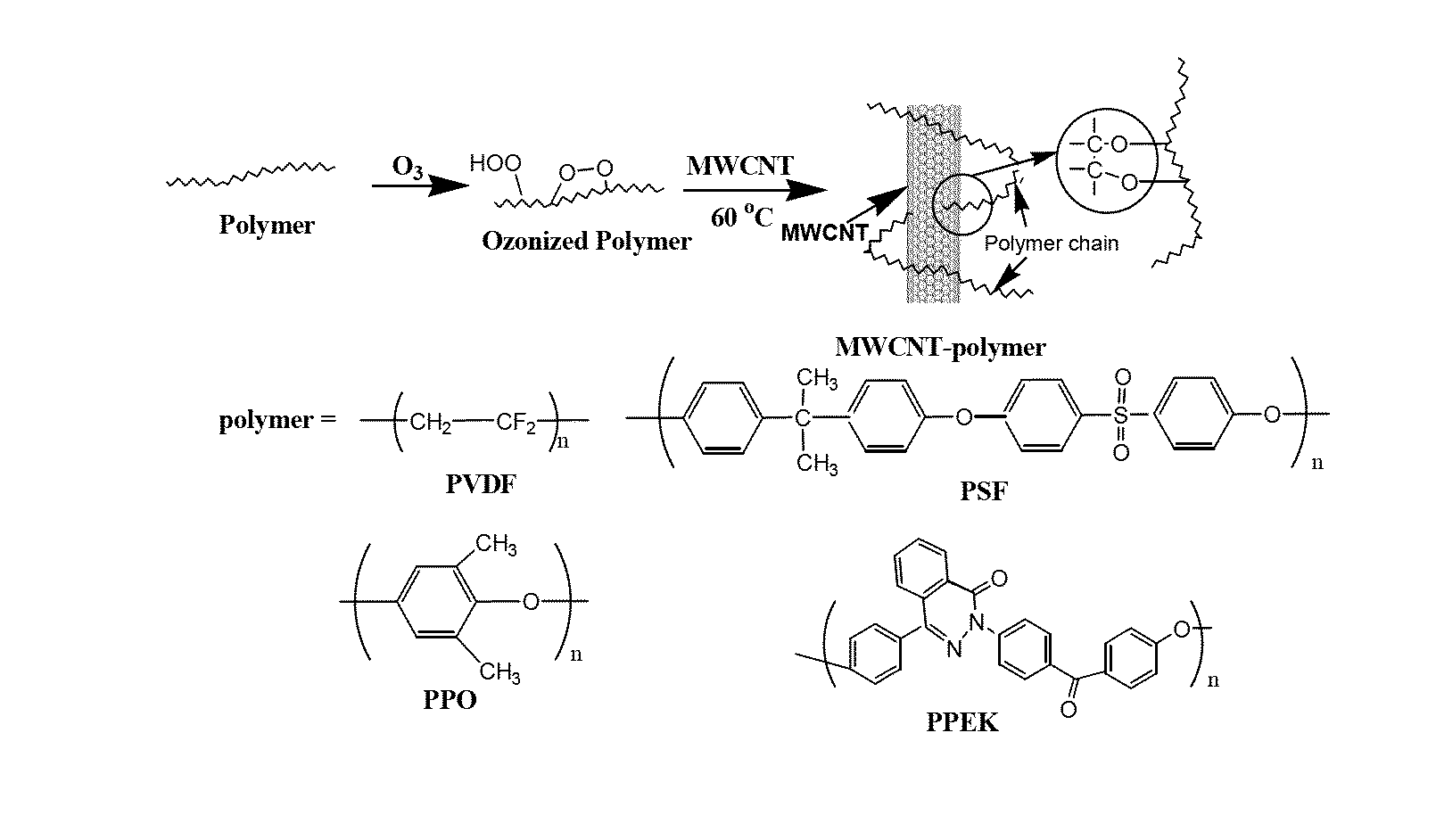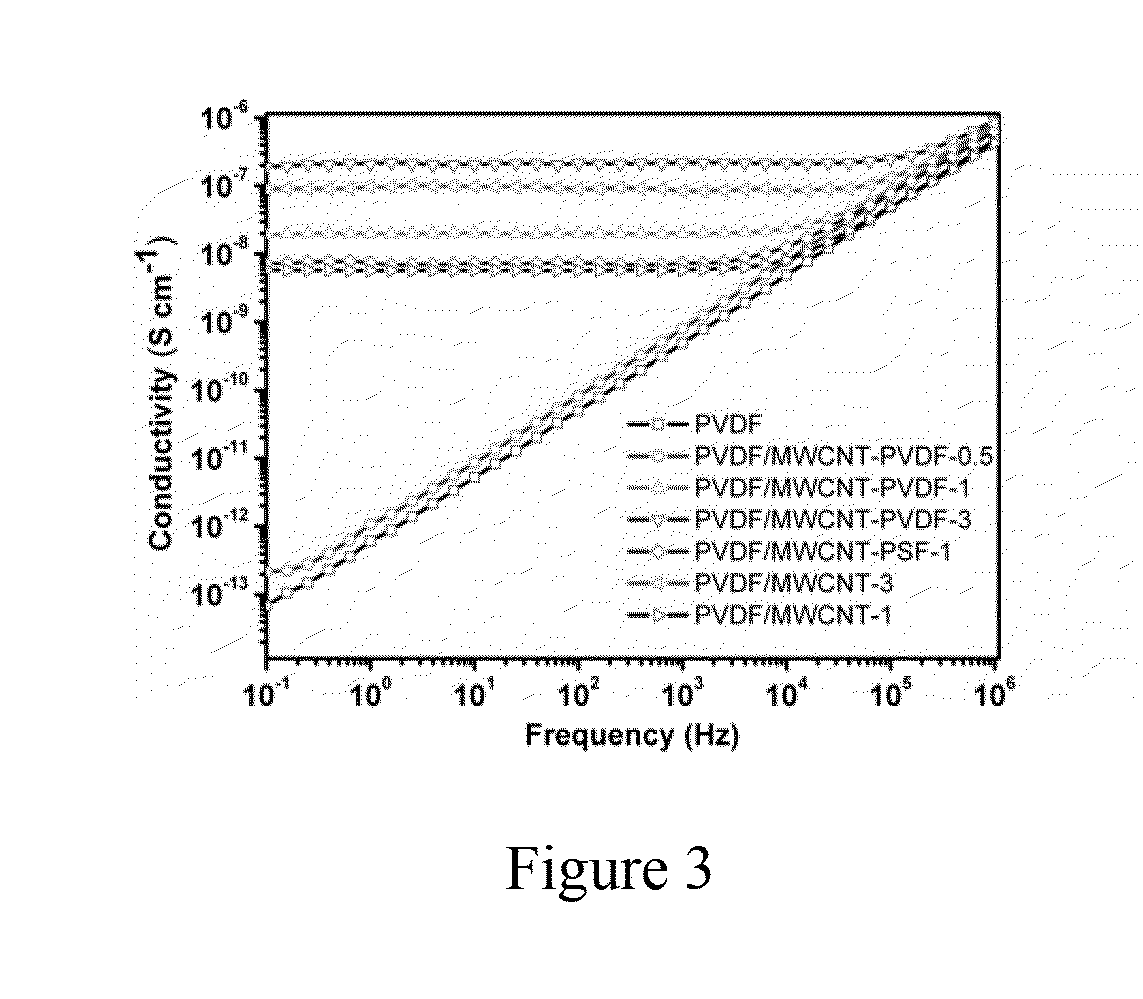Chemically Bonded Carbon Nanotube-Polymer Hybrid and Nanocomposite Thereof
a carbon nanotube and polymer technology, applied in material nanotechnology, fuel cells, electrochemical generators, etc., can solve the problems of not having a stable and non-reactive polymer, no reported method, functional group of polymers, etc., and achieve the effect of covalent bonding, increasing mechanical strength, or conducting or proton conductivity
- Summary
- Abstract
- Description
- Claims
- Application Information
AI Technical Summary
Benefits of technology
Problems solved by technology
Method used
Image
Examples
example 1
Preparation of a MWCNT-PVDF Hybrid
[0035]The commercial products of PVDF (Elf Atochem Inc. USA, Kynar K-761) and MWCNT (Carbon nanotube Co., Ltd., Incheon, Korea) are used. The purity of the MWCNT is 93% and was washed with dimethylsulfoxide (DMSO) prior to use. PVDF (0.3 g) was dissolved in 30 ml of 1-methyl-2-pyrrolidinone to form a PVDF polymer solution. A continuous stream of an O3 / O2 mixture (flow rate 6 L / min; O3 concentration 28 g / m3), which are generated by an ozone generator (Ozone group, Taiwan), then bubbled through the PVDF polymer solution at room temperature for 15 min. After the addition of 0.1 g MWCNT, the mixture was reacted at 60° C. for 30 min. MWCNTs were then collected with the filtration, washed with tetrahydrofuran, and dried under vacuum to give the product of MWCNT-PVDF (0.105 g). The PVDF fraction of MWCNT-PVDF measured with TGA is about 9 wt %. FIG. 1 shows a process flow of the formation of the carbon nanotube-polymer hybrid according to one embodiment of ...
example 2
Preparation of a MWCNT-PSF Hybrid
[0036]The preparation method that is the same as that of the example 1 is used except for using polysulfone (PSF, from Amoco Performance Inc. USA) as the polymer instead of PVDF and using DMF (N,N-dimethylformaldehyde) to dissolve PSF instead of 1-methyl-2-pyrrolidinone. The product MWCNT-PSF is obtained.
example 3
Preparation of a MWCNT-PPO Hybrid
[0037]The preparation method that is the same as that of the example 1 is used except for using poly(2,6-dimethylphenylene oxide (PPO, from General Electric Plastics) as the polymer instead of PVDF and using toluene to dissolve PPO instead of 1-methyl-2-pyrrolidinone. The product MWCNT-PPO is obtained.
PUM
| Property | Measurement | Unit |
|---|---|---|
| Fraction | aaaaa | aaaaa |
| Fraction | aaaaa | aaaaa |
| Time | aaaaa | aaaaa |
Abstract
Description
Claims
Application Information
 Login to View More
Login to View More - R&D
- Intellectual Property
- Life Sciences
- Materials
- Tech Scout
- Unparalleled Data Quality
- Higher Quality Content
- 60% Fewer Hallucinations
Browse by: Latest US Patents, China's latest patents, Technical Efficacy Thesaurus, Application Domain, Technology Topic, Popular Technical Reports.
© 2025 PatSnap. All rights reserved.Legal|Privacy policy|Modern Slavery Act Transparency Statement|Sitemap|About US| Contact US: help@patsnap.com



